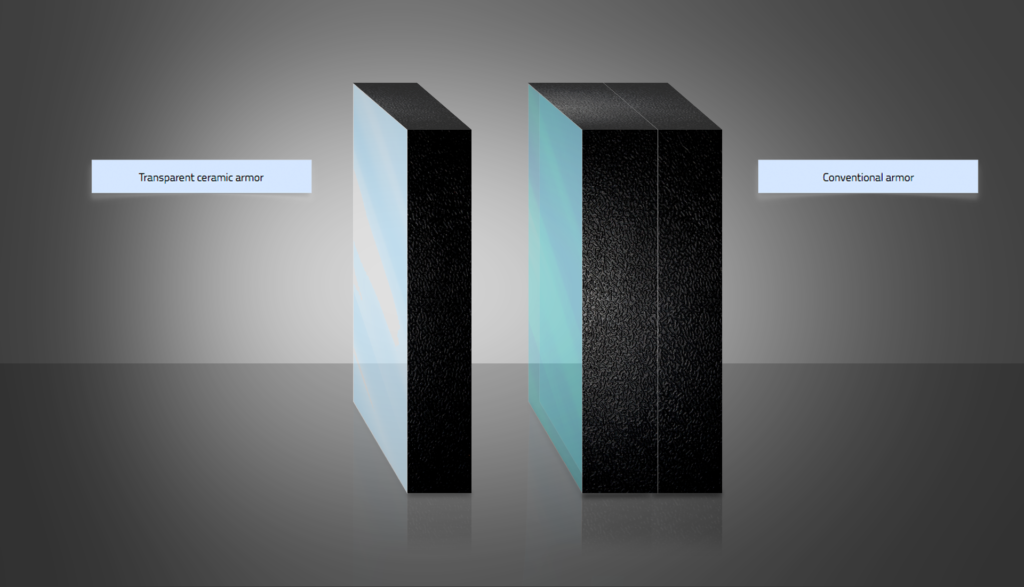
Technology
Transparent ceramics are highly durable optical materials in extreme conditions where conventional glass is unable to resist:
- They maintain their high visible and infrared transmission capabilities at high temperatures, above 1200 °C.
- They are chemically resistant in highly corrosive conditions.
- They exhibit more than three times in hardness and over five times in fracture strength.
Due to their outstanding mechanical and optical properties, transparent ceramics are commonly utilized in defense industry as armor material to protect vehicles from ballistic threats. When compared with conventional armors, they provide the same protection level by more than 60% reduced weight. A great deal of advantages that the transparent ceramics have make them possible to be used in many other applications from electro-optical fields to jewelry making.
We developed an economic powder-processing route and made this highly durable material available for non-military applications. Developed processing technology and applied sintering protocols also enable highly precise control over densification and microstructure of Mg-spinel (MgAl2O4). We use our expertise not only for marketing the material by matching the optical and mechanical properties with the intended application area but also to provide solutions and innovative designs for customized applications.

The table below compares the MagSpin with traditional (soda-lime) glass, tempered glass and sapphire. Tempered glass is the most common material used in mobile phone screens, whereas sapphire is widely utilized in watch screens. Having almost a three times higher hardness value than that for glass, MagSpin is highly scratch resistant; it is hardly possible to scratch a material of such hardness value in everyday use. Although the hardness value of MagSpin is slightly lower than that of sapphire, it has considerably lower manufacturing costs and advantageous in terms of ease of process. MagSpin can be produced by near-net-shape manufacturing technologies. It can directly be formed into a curved geometry, whereas sapphire needs to be cut and grinded. Moreover, it is also possible to embed a calligraphy or graphic design to the end product of MagSpin during its production.
* Values were measured with different loads. If the hardness of the MagSpin were measured with the same load used for glasses, a higher value would be expected to be measured.
Manufacturing
As a ceramic material, MagSpin too is produced by powder processing methods like others. Different from opaque ceramics, transparent ceramics have hardly any porosity (<0.01%). Every stage of MagSpin production is inspected precisely and carefully in order to reach the theoretical density and to prevent the formation of any possible defects in the body, which will otherwise result in the decreased optical transmission and/or optical homogeneity. Its defect free body that allows high optical transmission and controlled microstructure also bring superior mechanical properties to MagSpin.
One other favorable manufacturing property is the lower processing temperatures of MagSpin since it enables a more environmental friendly production in comparison to sapphire’s.
Properties
Obtained defect free and almost theoretically dense body provides MagSpin a clear and sharp vision with an optical transmission of 85% at 600 nm in the visible spectrum (from a 1 mm thick window with no antireflection coating). This is noticeably close to the theoretical transmission value of this material and consistent throughout the entire body. MagSpin exhibits even higher transmission characteristics (>90 %) in 1 – 5 µm region of the infrared spectrum.
In the quasistatic tests, Vickers hardness of MagSpin was measured as high as 1530 HV/10 (15 GPa), which is more than two times harder than the tempered glass and three times harder than the soda-lime glass. Hardness value may vary between 14 – 15 GPa depending on the compositions and different parameters used in the production process. These high hardness values guarantee that MagSpin is not susceptible to scratch in everyday use.
Manufacturing method of MagSpin ensures the possibility to have different toughness values throughout the product if required. Toughness is associated with the impact resistance and measured by indentation method. We can produce diverse microstructure designs to meet with the requirements of the specific application. For instance, one of our products, that is introduced as a phone screen, is reinforced at the sides and corners; the most vulnerable regions to impact. In this product, fracture toughness value changes from 1.7 MPa.m1/2 in transparent areas to 3.5 MPa.m1/2 in reinforced regions. After all, the toughness of MagSpin can be controlled to present regional differences in certain products.
MagSpin’s microstructure also provides a more convenient diffusion path for doping to create different colors. We create a nice black tint for a more appealing look and customize the level of transparency.


